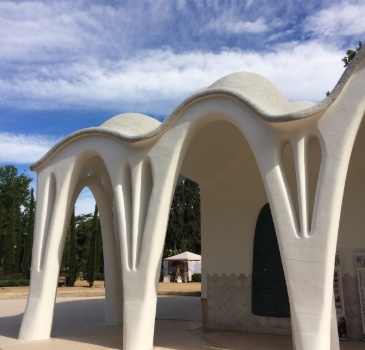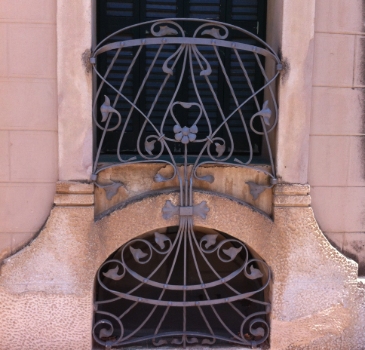During this Exclusive 9 hours tour you will visit Canet de Mar and Mataró, two towns which are authentic hidden gems of Art Nouveau in Catalonia.
Canet de Mar – 4 hour visit, including lunch in an Art Nouveau restaurant.
Castell de Santa Florentina (1.5h) – The private and exclusive visit to this place is probably the highlight of this private tour in Canet de Mar – Located near the village, has become the main tourist attraction of the Maresme region. A fame that intensified after the shoot of the season of “Games of Thrones”. The castle was built in medieval times but it experimented a last major reform at the end of 19th century, by the architect Lluís Domènech i Montaner. It is very remarkable the work on stained glass and marble. During this visit you will be served a glass of cava as a courtesy.
House-Museum of Lluís Domènech i Montaner (1h) – This great architect, author of works such as Palau de la Música and Hospital de Sant Pau, both in Barcelona, had a residence in the village because his wife had born there. They spent a lot of time there and the architect had a studio that you will discover during the visit.
You will have lunch in Casa Roura, a great restaurant located in an Art Nouveau building built by Lluís Domènech i Montaner dating 1892. The Casa Roura is a splendid example from one of his most fruitful periods and shows a painstaking use of the decorative and applied arts.
Canet de Mar has other interesting Art Nouveau buildings like the Ateneu, Passeig de la Misericòrdia or the industrial Art Nouveau building of Isidre Jover factory, but due to time constraints, the focus of the Canet de Mar tour will be done visiting the three buildings mentioned above.
Mataró – 2 hour visit, including the exclusive entry to two amazing buildings
Walking in the city you will discover the architecture for the summer houses in Mataró. You will have an exclusive access to the interior of two very interesting buildings:
- Nau Gaudí (1878-1883) – The first building of Antoni Gaudí, that helped him to prepare for the Sagrada Família construction. Considered the starting point of Gaudí’s creative process, this cotton bleaching shed stands out for its importance in his experimentation with parabolic arches, used here by the architect as structural elements for the first time. This architectural solution would subsequently become a key element and a very representative feature of Gaudí’s work.
- City Hall of Mataró (1893) – The roof of Sessions Hall was designed by Puig i Cadafalch, when that architect was the municipal architect of Mataró.
All days except Sunday you will also visit the interior of a shop that has preserved an astonishing Art Nouveau interior decorations. Other exteriors visited in Mataró are the house of Puig i Cadafalch, the market, Casa Parera (1894) and Casa Coll i Regàs, amongst others. An amazing and very complete visit to Mataró.
After your visit of Mataró, if you choose to book the private tour with our transport partner, our chauffeur will bring you back to your hotel in Barcelona, or alternatively in another place of the city. He will suggest you a restaurant which is located in the burgeoise neighbourghood of Barcelona and a more central restaurant, both in Art Nouveau style.
Canet de Mar is located 47km north of Barcelona and Mataró half-way there.
During the full day tour you will discover buildings designed by Lluis Domènech i Montaner, Puig i Cadafalch and Antoni Gaudí, the three top Catalan Art Nouveau architects.
A perfect and different Art Nouveau Day for you and your group. Book with us and get inspired.
Canet de Mar and Mataró, two hidden treasures north of Barcelona
Canet de Mar – Its priceless Catalan Art Nouveau heritage, with key works by Puig i Cadafalch and Domènech i Montaner, is the main attraction of the town. Strolling along its watercourse and the streets of the Old Town reveals true treasures such as the summer holiday home of architect Lluís Domènech i Montaner, today a museum. At the top of the watercourse stands the imposing castle of Santa Florentina, the gateway to the El Montnegre and El Corredor Park and, down by the sea, there are broad beaches of golden sand.
Mataró – Amongst other buildings, you will discover the first project from Antoni Gaudí (Nau Gaudí) and an amazing building interior (City Hall) by Puig i Cadafalch. The seaside town of Canet de Mar for centuries had alternated between an economy based on agriculture and fishing, enjoyed a period of wealth during the second half of the 19th century by converting itself into one of Catalonia’s leading producers of knitwear. As a result, the look of the town changed substantially and a new middle-class began constructing a variety of buildings that expressed the elaborate social structure in Canet de Mar at the time.
Pickup and Drop Off – Private tour starts and ends in front of your chosen hotel or accommodation in the Barcelona area.
If you choose not to book the transport with us, before the tour starts we will indicate the place to meet in Canet de Mar at 10am and the time to meet in Mataró around 2.30pm. Traveling on your own may result on a reduction of Art Nouveau buildings seen during the full day tour.
Our tour will take place, rain or shine.
Entry to all the buildings (castle, museum-house of Domènech i Montaner, Nau Gaudí, etc.).
Lunch at Casa Roura (you can find the MENU by clicking HERE) – Canet de Mar.
Other food and drinks.
Transport with our chauffer with private transport to Canet de Mar and Mataró, and return to Barcelona (extra fee).
If you require us, we can provide you with Airport pick-up and/or drop off (extra fee).




